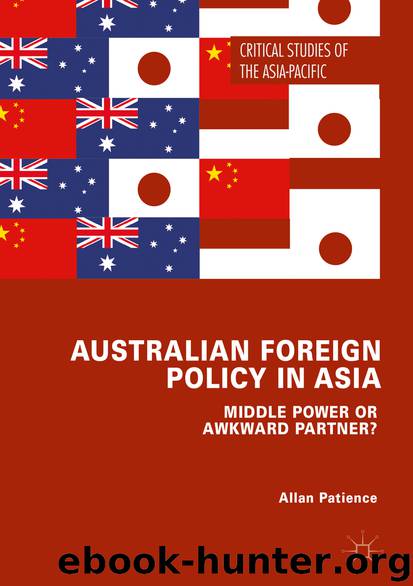Australian Foreign Policy in Asia by Allan Patience

Author:Allan Patience
Language: eng
Format: epub
Publisher: Springer International Publishing, Cham
Economic pragmatism in Australia began to shoulder aside the old racial prejudices and the postwar desire for revenge. Reparations on any large scale had been effectively ruled out during the peace negotiations with Japan. A potentially lucrative trade relationship began to glimmer as a light at the end of what had been a very long and dark wartime tunnel.
Australia-Japan Relations Since 1957
Diplomatic relations between Japan and Australia were formalized in 1952. While the relationship began to settle down after the Pacific War, it remained overwhelmingly focused on trade – principally resources exports. Commercial pragmatism began to displace the bitterness of the ‘war without mercy.’ Somewhat to their surprise and relief, Japanese athletes and accompanying officials were politely received at the 1956 Olympic Games in Melbourne. Japan’s ‘second economic miracle’ was taking off by the late 1950s, to the growing advantage of the Australian economy. Australian exporters began sniffing the Japanese trade winds. In 1957 Australia and Japan signed a trade agreement that was a key development in Japanese-Australian relations following the War. When this agreement was revised in 1965 Japan had grown to be one of Australia’s most significant trading partners, requiring resources such as coal, iron ore, bauxite, wheat, beef, sugar, and dairy products. Previously fearful of a remilitarized Japan, Macmahon Ball advised in 1965 that ‘it would seem good sense for Australia to work as closely as possible with Japan’ (1965, p. 269).
When the United Kingdom joined the European Union on 1 January 1973 the Australian government realized that the end of the road had come for relying on Commonwealth trade preferences with the United Kingdom (Benvenuti 2015). Indeed from the 1960s Australia’s economic gaze had been turning to Asia, especially Japan. Earlier, in 1971, the Whitlam Government had negotiated an agreement with the Sato Government for regular cabinet-level meetings between the two countries (Nakanishi 2011, p. 126). However the Australians were first and foremost looking for markets. Straightforward trade deals rather than nebulous regionalist or internationalist conversations were the order of the day. Working closely with the Japanese meant exporting mainly primary resources to their shores. H.W. Arndt identified the reasons for this proscriptive focus: ‘spectacular economic growth of Japan and the high degree of complementarity of the two economies’ (1972, p. 30). Large-scale minerals resource discoveries in Australia in the late 1950s and 1960s turned Australia from being primarily an agricultural exporter (wool, wheat, meat, sugar, and milk products) into a major mineral resources exporter (Blainey 2003). As British markets turned increasingly to Europe, Australia was obliged to look for markets in its region. With next to no resources of its own Japan was eager to enter into long-term trade agreements with Australia. This was more an arranged marriage of rather than a love match between the two countries. The growth of trade with Japan grew exponentially in the 1970s, with a decided imbalance in Australia’s favour. The Japanese tolerated this because their rapidly expanding economy was hungry (voraciously so) for the resources it needed for its spectacular industrial growth in these years (Vogel 1979).
Download
This site does not store any files on its server. We only index and link to content provided by other sites. Please contact the content providers to delete copyright contents if any and email us, we'll remove relevant links or contents immediately.
| Arms Control | Diplomacy |
| Security | Trades & Tariffs |
| Treaties | African |
| Asian | Australian & Oceanian |
| Canadian | Caribbean & Latin American |
| European | Middle Eastern |
| Russian & Former Soviet Union |
The Secret History by Donna Tartt(16621)
The Social Justice Warrior Handbook by Lisa De Pasquale(11489)
Thirteen Reasons Why by Jay Asher(7788)
This Is How You Lose Her by Junot Diaz(5769)
Weapons of Math Destruction by Cathy O'Neil(5036)
Zero to One by Peter Thiel(4824)
The Myth of the Strong Leader by Archie Brown(4789)
Promise Me, Dad by Joe Biden(4447)
Beartown by Fredrik Backman(4415)
Stone's Rules by Roger Stone(4415)
How Democracies Die by Steven Levitsky & Daniel Ziblatt(4398)
The Fire Next Time by James Baldwin(4342)
100 Deadly Skills by Clint Emerson(4076)
A Higher Loyalty: Truth, Lies, and Leadership by James Comey(4032)
Rise and Kill First by Ronen Bergman(4012)
The David Icke Guide to the Global Conspiracy (and how to end it) by David Icke(3881)
The Farm by Tom Rob Smith(3872)
Secrecy World by Jake Bernstein(3782)
The Doomsday Machine by Daniel Ellsberg(3730)
